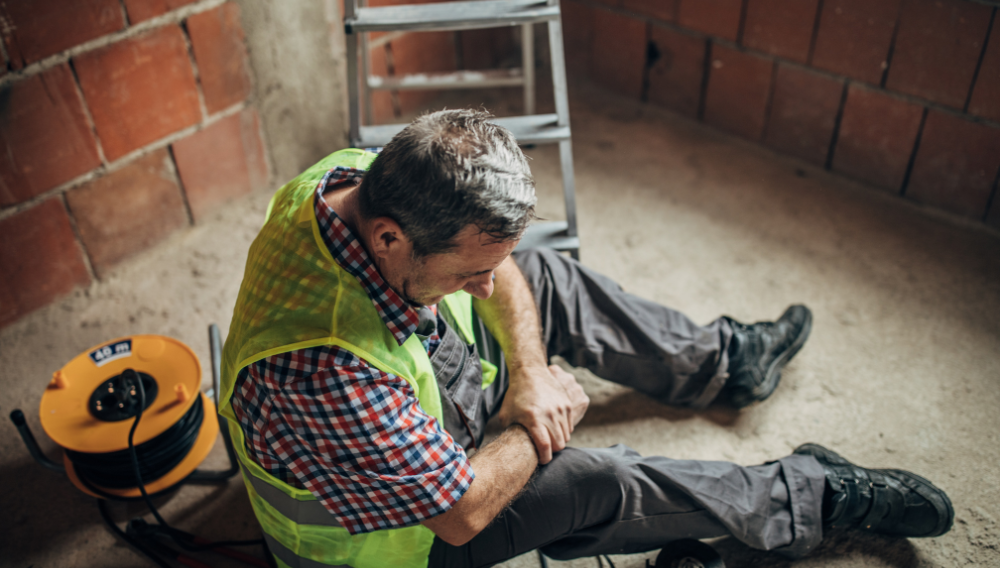Work Injuries
Move Better. Live Fuller. Your Wellness Journey Starts Here.
Schedule a FREE Discovery Call!
About Work Injuries
Work injuries are injuries that occur during or because of a job, whether it be due to the repetitive motions, poor ergonomics, or accidents that cause acute injury. Workplaces and job responsibilities can vary widely, which means the types of injuries experienced can vary, too; including sudden injuries or chronic injuries that occur over time.
Injuries created by jobs can cause a range of symptoms, some of which may make doing your job uncomfortable, difficult, or impossible. In many cases, injuries that form due to a long-term career can worsen if ignored.
Therefore, if you experience any type of injury or pain related to your job, it is important to seek proper care. After all, you need your body to do the things you enjoy outside of work, too!

The nature of your work injury will depend on the type of job you have. Practically any job can create injury, even if you aren’t moving much throughout the day. Anyone can experience an injury at work: Office workers, retail employees, factory workers, truck drivers, restaurant workers… the list can go on and on!
With that being said, consider if you engage in any of the following tasks often in your career:
- Prolonged standing
- Prolonged sitting
- Usage of a computer
- Frequent bending or lifting
- Repetitive movements of the wrists or hands
- Awkward postures or positions
- Managing heavy loads
- Overhead lifting or reaching
- Pushing, pulling, or carrying of items
- Other laborious tasks
These are just some examples of movements or factors that can create injuries in a job. With that being said, let’s talk about some common types of injuries that occur in the workplace.
Common Types of Work Injuries
As mentioned before, work injuries can be either acute or chronic. Acute injuries are described as sudden injuries that typically heal within a few months. Chronic conditions are those that may occur gradually and worsen with time. Chronic injuries usually cause pain that lasts for many months or even years.
For many individuals, injuries caused by job-related tasks can affect areas such as the spine, shoulders, wrists, knees, neck, or lower back; but work injuries can vary greatly depending on the individual and the job.
Acute Injuries
Acute injuries can happen for a variety of reasons, often occurring due to a mixture of environmental, situational, and physical causes. Acute work injuries are usually injuries caused by accidents or sudden impact, such as:
- Falls (due to imbalance, slipping, or tripping)
- Direct impact (such as from falling items, running into something, etc.)
- Overexertion (such as from picking up heavy items incorrectly, working while fatigued, etc.)
Some examples of acute injuries include fractures, sprains and strains, dislocations, and more. These injuries can vary in severity, causing anything from mild pain to severe pain requiring extensive care.
Ergonomic / Environment Related Injuries
The environment you work in can be a cause of injury too, either directly or indirectly. Even environments that seem perfectly safe (like an office) can still have certain aspects that contribute to injury.
Factors such as poor ergonomics, environmental hazards, and intensive work requirements can significantly contribute to injury. These factors can range widely depending on the type of job, but we’ve provided some examples below:
- Workspace hazards (loose cords, misplaced items, uneven flooring, etc.)
- Broken or faulty equipment
- Not following safety regulations
- Working long hours without sufficient breaks
- Desks, chairs, and other tools that fail to support good posture
Many environmental causes can be prevented by making ergonomic changes to your workspace, ensuring you take sufficient breaks, reporting any hazards, and replacing faulty equipment. If you’d like advice on how to improve your workspace or office ergonomics, check out our free guide!
Overuse / Repetitive Injuries
In many different types of jobs, repetitive motions are common. This can include standing all day, sitting all day, typing on a keyboard, lifting boxes, scanning items, folding clothes—practically any movement that you do frequently at your job. These types of motions can cause repetitive stress injuries. Repetitive stress injuries commonly affect your wrists, elbows, shoulders, back, knees, hands, and more. Some examples can include wrist pain from typing all day, back pain from prolonged sitting or frequently bending over, or pain from assembly line work. Repetitive stress injuries are a very common type of work injury!
Other Contributing Factors
Many injuries are caused by a mixture of factors. Some types of injuries may seem unavoidable, but a physical therapist is actually able to provide education and physical treatment to help take some of the strain off your body while you work.
For example, having poor posture, muscle imbalances, or movement mechanics can significantly contribute to your risk of acute or repetitive stress injuries. Lifting with poor form, hunching at your desk, or holding the same posture for a long period of time can affect the muscles, bones, ligaments, and tendons in your body—causing stress, fatigue, and pain in these areas that can make injury more likely.
Therefore, your physical therapist will be sure to assess all of these factors and how they relate to your unique job tasks. They’ll also consider these important factors while formulating your care plan!
Physical Therapy for Work Injuries
Physical therapy plays an important role in rehabilitation and recovery from work related injuries. Receiving treatment at Hive can relieve your pain and allow you to return to work and daily life with restored function.
The physical therapists at Hive work to restore your function and range of motion through a variety of treatment methods. These treatments are chosen based on your unique needs and type of injury. In order to formulate a care plan that is best for you, your physical therapist will conduct a thorough evaluation.
An evaluation will allow them to discuss your medical history, request details of the injury, and perform physical examinations as well. More specifically, your evaluation may include the following:
- Discussing your work environment and job demands or tasks.
- Discussion of the injury, how it occurred, and its symptoms.
- Exploration of any relevant past injuries or surgeries to the injured area.
- A physical assessment of the injury and surrounding muscles groups.
- Evaluation of your posture, gait, or movement patterns relevant to your job.
- Tests to evaluate your range of motion, flexibility, or strength.
- Simulation or exploration of frequent work-related movements.
- Identifying ergonomic factors relating to the workplace environment or work-related movements.
This evaluation will allow your physical therapist to get a better idea of your current level of physical health, what your job entails, and what postures, movements, or other factors may have contributed to your injury. By examining your injury and considering other relevant factors, your physical therapist will be able to see what treatments are best for your rehabilitation needs. Below, we’ve outlined some treatment methods that are commonly used for work injury rehabilitation at Hive Therapy and Wellness:
Pain Management
Both acute and chronic work injuries can cause significant pain. The physical therapists at Hive offer many pain-relieving treatments that can be utilized according to your unique injury. Some examples include:
Therapeutic modalities
- Temperature therapy (heat or cold)
- Electrical muscle stimulation
- Heat or ice therapy
- Laser therapy
Manual Therapies
- Dry needling
- Tissue scraping
- Cupping
- Hands-on techniques
Not only do these treatments relieve pain, but many of them mobilize soft tissues and joints for better range of motion and flexibility. Many of these treatments can decrease muscle tension, improve blood flow, and even encourage better function.
Neuromuscular Re-Education
In cases where an injury is caused by poor posture or repetitive movements, a physical therapist can provide valuable treatment and education to prevent re-injury.
Neuromuscular re-education is a treatment that encourages better coordination between your brain and movements. In other words, it is a form of movement retraining that corrects harmful movement patterns that can contribute to injury and pain. By incorporating this type of treatment into your care plan, your physical therapist can retrain your work-related movements to ensure safe performance of your job’s tasks. This treatment can focus on any type of movement, such as:
- Walking
- Lifting
- Bending over
- Reaching overhead
- Movements involving your arms, shoulders, or hands
- And more
Strengthening and Stretching
Improving your body’s strength and flexibility is important not just for rehabilitation from injury, but also for preventing future injury! Your physical therapist will work to safely restore strength and movement to your injured area with controlled exercises that gradually become more challenging as you heal. They’ll lead you through gentle stretches and mobility exercises that will restore function and reduce stiffness caused by your injury.
However, they won’t just stop at the site of injury. After all, the body doesn’t use one set of muscles for movements. Many muscle groups coordinate to allow for effective movement—for example, lifting an item off the floor requires effort from your back, hips, shoulders, abdominals, and more.
Therefore, your physical therapist will create an individualized exercise routine that will alleviate muscle imbalances, reduce your risk of injury, and improve your function.
Education and Long-Term Care
In order to provide a comprehensive treatment experience, your Hive physical therapist will be sure to provide you with education, advice, and resources to prevent future injury. This can include a variety of things, such as:
- Suggestions for creating a more ergonomic work environment
- Strategies to maintain good posture
- An at-home exercise plan to help you maintain good strength and flexibility
- Tool suggestions or other strategies to reduce pain
Your Hive physical therapist is dedicated to restoring your function and helping you maintain long-term health so that you can return to work and other activities comfortably. They can provide assistance for the transition back to work, such as determining if you are ready to return to work, modifying tasks temporarily as you complete recovery, and offering re-assessments to prevent re-injury.
The examples above are just some of the ways a physical therapist can support you after a work injury. The providers at Hive Therapy and Wellness will use a variety of treatments that best support your recovery needs and goals. These treatments can include any of the examples described above, as well any of the following:
- Neuromuscular re-education
- Manual therapy
- Exercise prescription
- Dry needling
- Cupping
- Tissue scraping
- Behavioral modifications
- Therapeutic activities
- Electrical muscle stimulation
- Spinal manipulation
- Therapeutic modalities
- Biofeedback
Work injuries are injuries that occur during or because of a job, whether it be due to the repetitive motions, poor ergonomics, or accidents that cause acute injury.
Workplaces and job responsibilities can vary widely, which means the types of injuries experienced can vary, too; including sudden injuries or chronic injuries that occur over time.
Injuries created by jobs can cause a range of symptoms, some of which may make doing your job uncomfortable, difficult, or impossible. In many cases, injuries that form due to a long-term career can worsen if ignored.
Therefore, if you experience any type of injury or pain related to your job, it is important to seek proper care. After all, you need your body to do the things you enjoy outside of work, too!
The nature of your work injury will depend on the type of job you have. Practically any job can create injury, even if you aren’t moving much throughout the day.
Anyone can experience an injury at work: Office workers, retail employees, factory workers, truck drivers, restaurant workers… the list can go on and on!
With that being said, consider if you engage in any of the following tasks often in your career:
- Prolonged standing
- Prolonged sitting
- Usage of a computer
- Frequent bending or lifting
- Repetitive movements of the wrists or hands
- Awkward postures or positions
- Managing heavy loads
- Overhead lifting or reaching
- Pushing, pulling, or carrying of items
- Other laborious tasks
These are just some examples of movements or factors that can create injuries in a job. With that being said, let’s talk about some common types of injuries that occur in the workplace.
As mentioned before, work injuries can be either acute or chronic. Acute injuries are described as sudden injuries that typically heal within a few months.
Chronic conditions are those that may occur gradually and worsen with time. Chronic injuries usually cause pain that lasts for many months or even years.
For many individuals, injuries caused by job-related tasks can affect areas such as the spine, shoulders, wrists, knees, neck, or lower back; but work injuries can vary greatly depending on the individual and the job.
Acute Injuries
Acute injuries can happen for a variety of reasons, often occurring due to a mixture of environmental, situational, and physical causes. Acute work injuries are usually injuries caused by accidents or sudden impact, such as:
- Falls (due to imbalance, slipping, or tripping)
- Direct impact (such as from falling items, running into something, etc.)
- Overexertion (such as from picking up heavy items incorrectly, working while fatigued, etc.)
Some examples of acute injuries include fractures, sprains and strains, dislocations, and more. These injuries can vary in severity, causing anything from mild pain to severe pain requiring extensive care.
Ergonomic / Environment Related Injuries
The environment you work in can be a cause of injury too, either directly or indirectly. Even environments that seem perfectly safe (like an office) can still have certain aspects that contribute to injury.
Factors such as poor ergonomics, environmental hazards, and intensive work requirements can significantly contribute to injury. These factors can range widely depending on the type of job, but we’ve provided some examples below:
- Workspace hazards (loose cords, misplaced items, uneven flooring, etc.)
- Broken or faulty equipment
- Not following safety regulations
- Working long hours without sufficient breaks
- Desks, chairs, and other tools that fail to support good posture
Many environmental causes can be prevented by making ergonomic changes to your workspace, ensuring you take sufficient breaks, reporting any hazards, and replacing faulty equipment. If you’d like advice on how to improve your workspace or office ergonomics, check out our free guide!
Overuse / Repetitive Injuries
In many different types of jobs, repetitive motions are common. This can include standing all day, sitting all day, typing on a keyboard, lifting boxes, scanning items, folding clothes—practically any movement that you do frequently at your job.
These types of motions can cause repetitive stress injuries. Repetitive stress injuries commonly affect your wrists, elbows, shoulders, back, knees, hands, and more.
Some examples can include wrist pain from typing all day, back pain from prolonged sitting or frequently bending over, or pain from assembly line work. Repetitive stress injuries are a very common type of work injury!
Other Contributing Factors
Many injuries are caused by a mixture of factors. Some types of injuries may seem unavoidable, but a physical therapist is actually able to provide education and physical treatment to help take some of the strain off your body while you work.
For example, having poor posture, muscle imbalances, or movement mechanics can significantly contribute to your risk of acute or repetitive stress injuries.
Lifting with poor form, hunching at your desk, or holding the same posture for a long period of time can affect the muscles, bones, ligaments, and tendons in your body—causing stress, fatigue, and pain in these areas that can make injury more likely.
Therefore, your physical therapist will be sure to assess all of these factors and how they relate to your unique job tasks. They’ll also consider these important factors while formulating your care plan!
Physical therapy plays an important role in rehabilitation and recovery from work related injuries. Receiving treatment at Hive can relieve your pain and allow you to return to work and daily life with restored function.
The physical therapists at Hive work to restore your function and range of motion through a variety of treatment methods. These treatments are chosen based on your unique needs and type of injury.
In order to formulate a care plan that is best for you, your physical therapist will conduct a thorough evaluation.
An evaluation will allow them to discuss your medical history, request details of the injury, and perform physical examinations as well. More specifically, your evaluation may include the following:
- Discussing your work environment and job demands or tasks.
- Discussion of the injury, how it occurred, and its symptoms.
- Exploration of any relevant past injuries or surgeries to the injured area.
- A physical assessment of the injury and surrounding muscles groups.
- Evaluation of your posture, gait, or movement patterns relevant to your job.
- Tests to evaluate your range of motion, flexibility, or strength.
- Simulation or exploration of frequent work-related movements.
- Identifying ergonomic factors relating to the workplace environment or work-related movements.
This evaluation will allow your physical therapist to get a better idea of your current level of physical health, what your job entails, and what postures, movements, or other factors may have contributed to your injury.
By examining your injury and considering other relevant factors, your physical therapist will be able to see what treatments are best for your rehabilitation needs.
Below, we’ve outlined some treatment methods that are commonly used for work injury rehabilitation at Hive Therapy and Wellness:
Pain Management
Both acute and chronic work injuries can cause significant pain. The physical therapists at Hive offer many pain-relieving treatments that can be utilized according to your unique injury. Some examples include:
Therapeutic modalities
- Temperature therapy (heat or cold)
- Electrical muscle stimulation
- Heat or ice therapy
- Laser therapy
Manual Therapies
- Dry needling
- Tissue scraping
- Cupping
- Hands-on techniques
Not only do these treatments relieve pain, but many of them mobilize soft tissues and joints for better range of motion and flexibility.
Many of these treatments can decrease muscle tension, improve blood flow, and even encourage better function.
Neuromuscular Re-Education
In cases where an injury is caused by poor posture or repetitive movements, a physical therapist can provide valuable treatment and education to prevent re-injury.
Neuromuscular re-education is a treatment that encourages better coordination between your brain and movements. In other words, it is a form of movement retraining that corrects harmful movement patterns that can contribute to injury and pain.
By incorporating this type of treatment into your care plan, your physical therapist can retrain your work-related movements to ensure safe performance of your job’s tasks. This treatment can focus on any type of movement, such as:
- Walking
- Lifting
- Bending over
- Reaching overhead
- Movements involving your arms, shoulders, or hands
- And more
Strengthening and Stretching
Improving your body’s strength and flexibility is important not just for rehabilitation from injury, but also for preventing future injury!
Your physical therapist will work to safely restore strength and movement to your injured area with controlled exercises that gradually become more challenging as you heal.
They’ll lead you through gentle stretches and mobility exercises that will restore function and reduce stiffness caused by your injury.
However, they won’t just stop at the site of injury. After all, the body doesn’t use one set of muscles for movements.
Many muscle groups coordinate to allow for effective movement—for example, lifting an item off the floor requires effort from your back, hips, shoulders, abdominals, and more.
Therefore, your physical therapist will create an individualized exercise routine that will alleviate muscle imbalances, reduce your risk of injury, and improve your function.
Education and Long-Term Care
In order to provide a comprehensive treatment experience, your Hive physical therapist will be sure to provide you with education, advice, and resources to prevent future injury. This can include a variety of things, such as:
- Suggestions for creating a more ergonomic work environment
- Strategies to maintain good posture
- An at-home exercise plan to help you maintain good strength and flexibility
- Tool suggestions or other strategies to reduce pain
Your Hive physical therapist is dedicated to restoring your function and helping you maintain long-term health so that you can return to work and other activities comfortably.
They can provide assistance for the transition back to work, such as determining if you are ready to return to work, modifying tasks temporarily as you complete recovery, and offering re-assessments to prevent re-injury.
The examples above are just some of the ways a physical therapist can support you after a work injury. The providers at Hive Therapy and Wellness will use a variety of treatments that best support your recovery needs and goals.
These treatments can include any of the examples described above, as well any of the following:
- Neuromuscular re-education
- Manual therapy
- Exercise prescription
- Dry needling
- Cupping
- Tissue scraping
- Behavioral modifications
- Therapeutic activities
- Electrical muscle stimulation
- Spinal manipulation
- Therapeutic modalities
- Biofeedback
You can learn more about these treatments on our Treatments Page.





